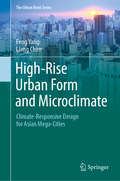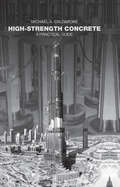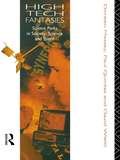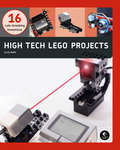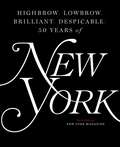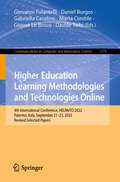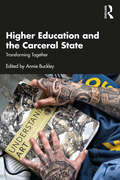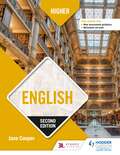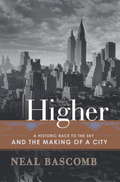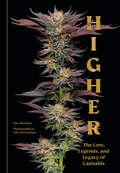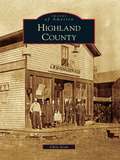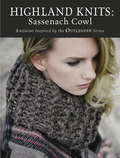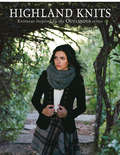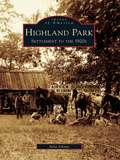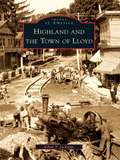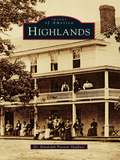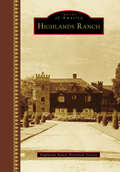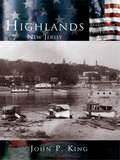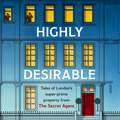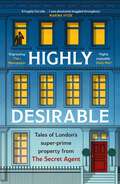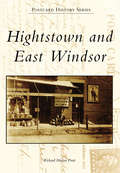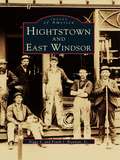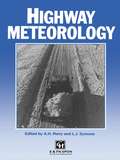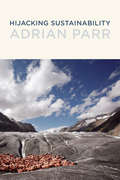- Table View
- List View
High-Rise Urban Form and Microclimate: Climate-Responsive Design for Asian Mega-Cities (The Urban Book Series)
by Feng Yang Liang ChenThe book comprehensively investigates the relationship between critical urban form and fabric parameters and urban microclimate in the high-rise urban environment that prevails in Asian megacities such as Shanghai. It helps readers gain a deeper understanding of climate-responsive urban design strategies and tactics for effectively mitigating the negative impacts of deteriorating urban thermal environments on pedestrian thermal comfort, outdoor air quality and building energy consumption. It also reviews the latest advances in urban climate research, with a focus on the challenges in terms of outdoor space comfort, health, and livability posed by the high-rise and high-density development in emerging Asian megacities, and proposes an integrated framework in response to the pressing need for microclimate research. It then presents a series of studies on high-rise residential and non-residential urban neighborhoods and districts based on instrumented field study, validated numerical simulation, and spatial analysis using a GIS platform. The book includes extensive, valuable experimental data presented in a clear and concise manner. The thermal atlas methodology based on empirical modeling and spatial analysis described is a useful climate-responsive design tool for both urban designer and architects. As such, the book is of particular interest to researchers, professionals, and graduate students in the fields of urban planning and design, building science and urban climatology.
High-Strength Concrete: A Practical Guide
by Michael A. CaldaroneThis practical book from a highly experienced author presents clearly the means and methods for designing, producing and using high-strength concrete.High-strength concrete offers many benefits. Higher compressive strengths allow for a reduction in the cross-sectional dimensions of columns and walls in buildings. Its greater stiffness allows for increasing building heights while controlling sway and occupant comfort. Civil structures such as bridges have benefited from greater span lengths, shallower beam sections, wider girder spacing, and extended service life.Illustrated with real life examples, through documented case histories, High-Strength Concrete will be a valuable resource for contractors, producers, inspection agencies, as well as engineers and researchers.
High-Tech Fantasies: Science Parks in Society, Science and Space
by Doreen Massey David WieldScience parks are becoming established in increasing numbers in almost all parts of the world. Promoted as places on the frontiers of science where a new breed of scientist-entrepreneur invents a new future, extolled as high-status workplaces where a new style of employee and flexible labour process is in the making, they are seen as the potential saviours of local and national economies. High-Tech Fantasies criticises the divisive hype of science parks arguing that both the theory and practice are unproductive for the economy and for any socially progressive science and technology. Questioning responsibility, innovation and symbolism, the authors explore the mutual determination of society, science and space.
High-Tech LEGO Projects: 16 Rule-Breaking Inventions
by Grady KochA collection of 16 fascinating scientific and technical projects to build with parts from the LEGO MINDSTORMS EV3 robotics set and other components. A great addition to any STEM curriculum or home library.High Tech LEGO® hijacks the MINDSTORMS® EV3 revolution, showing you how to build creative technical inventions with practical applications. You'll learn to build a dynamic array of working devices for outdoor research, home security, spycraft, and more.Among the book's 16 fascinating projects you'll find a motion-activated animal cam, a Morse code transmitter, a laser security fence, a motion-sensing radar detector, an automated insect trapper, and a heat-seeking infrared cannon. Welcome to a whole new world of building!Every project brings together science, mechanics, electronics, optics, and software to create complex instruments for studying and measuring the world around you, all while maintaining the playfulness of LEGO. Each easy-to-follow model combines illustrated instructions with step-by-step guidance on the engineering methods at play.As you build, you'll learn: • "Illegal" modding techniques (that may include drilling, cutting and soldering -- Shh!) • Different ways to work with diode laser modules • Tricks for modifying EV3 sensors and motors • The joy of hacking LEGO light bricks to make a flickering fireplace • How to use MINDSTORMS to build your own contraptions!Experiment on your own, and expand on your finished creations. Make a few adjustments so the Critter Cam triggers an alarm to scare away pests, or modify the Doppler radar to detect flammable gases. The possibilities are endless!REQUIREMENTS: LEGO® MINDSTORMS® EV3 Home Edition Windows Vista or higher macOS 10.14 or earlier
Highbrow, Lowbrow, Brilliant, Despicable: Fifty Years of New York Magazine
by The Editors of New York MagazineNew York, the city. New York, the magazine. A celebration.The great story of New York City in the past half-century has been its near collapse and miraculous rebirth. A battered town left for dead, one that almost a million people abandoned and where those who remained had to live behind triple deadbolt locks, was reinvigorated by the twinned energies of starving artists and financial white knights. Over the next generation, the city was utterly transformed. It again became the capital of wealth and innovation, an engine of cultural vibrancy, a magnet for immigrants, and a city of endless possibility. It was the place to be—if you could afford it. Since its founding in 1968, New York Magazine has told the story of that city’s constant morphing, week after week. Covering culture high and low, the drama and scandal of politics and finance, through jubilant moments and immense tragedies, the magazine has hit readers where they live, with a sensibility as fast and funny and urbane as New York itself. From its early days publishing writers like Tom Wolfe, Jimmy Breslin, and Gloria Steinem to its modern incarnation as a laboratory of inventive magazine-making, New York has had an extraordinary knack for catching the Zeitgeist and getting it on the page. It was among the originators of the New Journalism, publishing legendary stories whose authors infiltrated a Black Panther party in Leonard Bernstein’s apartment, introduced us to the mother-daughter hermits living in the dilapidated estate known as Grey Gardens, launched Ms. Magazine, branded a group of up-and-coming teen stars “the Brat Pack,” and effectively ended the career of Roger Ailes. Again and again, it introduced new words into the conversation—from “foodie” to “normcore”—and spotted fresh talent before just about anyone. Along the way, those writers and their colleagues revealed what was most interesting at the forward edge of American culture—from the old Brooklyn of Saturday Night Fever to the new Brooklyn of artisanal food trucks, from the Wall Street crashes to the hedge-fund spoils, from The Godfather to Girls—in ways that were knowing, witty, sometimes weird, occasionally vulgar, and often unforgettable. On “The Approval Matrix,” the magazine’s beloved back-page feature, New York itself would fall at the crossroads of highbrow and lowbrow, and more brilliant than despicable. (Most of the time.) Marking the magazine’s fiftieth birthday, Highbrow, Lowbrow, Brilliant, Despicable: 50 Years of New York draws from all that coverage to present an enormous, sweeping, idiosyncratic picture of a half-century at the center of the world. Through stories and images of power and money, movies and food, crises and family life, it constitutes an unparalleled history of that city’s transformation, and of a New York City institution as well. It is packed with behind-the-scenes stories from New York’s writers, editors, designers, and journalistic subjects—and frequently overflows its own pages onto spectacular foldouts. It’s a big book for a big town.
Higher Education Learning Methodologies and Technologies Online: 4th International Conference, HELMeTO 2022, Palermo, Italy, September 21–23, 2022, Revised Selected Papers (Communications in Computer and Information Science #1779)
by Daniel Burgos Marta Cimitile Davide Taibi Gabriella Casalino Giovanni Fulantelli Giosuè Lo BoscoThis book constitutes the thoroughly refereed post-conference proceedings of the 4th International Conference on Higher Education Learning Methodologies and Technologies Online, HELMeTO 2022, held in Palermo, Italy, in September 2022. The 59 revised papers presented were carefully reviewed and selected from a total of 126 submissions. The papers present recent research on challenges of implementing emerging technology solution for online, online learning pedagogical frameworks, online learning technologies in practice, online learning strategies and resources, etc.
Higher Education and the Carceral State: Transforming Together
by Annie BuckleyHigher Education and the Carceral State: Transforming Together explores the diversity of ways in which university faculty and students are intervening in the system of mass incarceration through the development of transformative arts and educational programs for students in correctional institutions.Demonstrating the ways that higher education can intervene in and disrupt the deeply traumatic experience of incarceration and shift the embedded social-emotional cycles that lead to recidivism, this book is both inspiration and guide for those seeking to create and sustain programs as well as to educate students about the types of programs universities bring to prisons.From arts workshops and educational courses to degree-granting programs, individuals and communities across multiple disciplines in higher education are actively breaking the cycle of shame and division in mass incarceration through direct engagement. This book explores the inspiring, innovative, and changemaking initiatives in carceral spaces - from arts workshops and educational courses to degree granting programs - through the lens of faculty, artists, scholars, students, and administrators. Readers will learn the diverse ways in which these interventions and partnerships can take shape and the life changing impacts that they have on all those involved, in particular students who are incarcerated. The book includes authors with lived experience of incarceration throughout.Section I highlights the voices of students who are currently or formerly incarcerated, while Section II addresses diverse collaborations through and across systems of corrections and education. Section III features the voices of teaching artists, while Section IV includes those that start and lead these programs, offering roadmaps for others interested in engaging in this transformative work.
Higher English, Second Edition
by Jane CooperExam Board: SQALevel: HigherSubject: BiologyFirst Teaching: August 2018First Exam: June 2019Ensure that students are prepared for every aspect of Higher Biology with the new edition of this popular textbook from James Torrance and his renowned author team, completely updated for the 2018 changes to the SQA Higher Biology syllabus.- Suggested learning activities throughout help to develop students' knowledge and skills including all new case studies, research topics and investigations- Testing your knowledge questions at the end of each chapter provide opportunities to continually assess Knowledge and Understanding, and are particularly useful for homework tasks- 'What you should know' summaries of key facts and concepts provide an excellent source of material for consolidation and revision prior to the SQA examination.- 'Applying Your Knowledge and Skills' sections at the end of each section have been substantially extended to give students extra practice in exam questions and foster the development of Skills of Scientific Experimentation, Investigation and Enquiry
Higher: A Historic Race to the Sky and the Making of a City
by Neal BascombThe Roaring Twenties in New York was a time of exuberant ambition, free-flowing optimism, an explosion of artistic expression in the age of Prohibition. New York was the city that embodied the spirit and strength of a newly powerful America. In 1924, in the vibrant heart of Manhattan, a fierce rivalry was born. Two architects, William Van Alen and Craig Severance (former friends and successful partners, but now bitter adversaries), set out to imprint their individual marks on the greatest canvas in the world--the rapidly evolving skyline of New York City. Each man desired to build the city's tallest building, or 'skyscraper. ' Each would stop at nothing to outdo his rival. Van Alen was a creative genius who envisioned a bold, contemporary building that would move beyond the tired architecture of the previous century. By a stroke of good fortune he found a larger-than-life patron in automobile magnate Walter Chrysler, and they set out to build the legendary Chrysler building. Severance, by comparison, was a brilliant businessman, and he tapped his circle of downtown, old-money investors to begin construction on the Manhattan Company Building at 40 Wall Street. From ground-breaking to bricklaying, Van Alen and Severance fought a cunning duel of wills. Each man was forced to revamp his architectural design in an attempt to push higher, to overcome his rival in mid-construction, as the structures rose, floor by floor, in record time. Yet just as the battle was underway, a third party entered the arena and announced plans to build an even larger building. This project would be overseen by one of Chrysler's principal rivals--a representative of the General Motors group--and the building ultimately became known as The Empire State Building. Infused with narrative thrills and perfectly rendered historical and engineering detail, Higher brings to life a sensational episode in American history. Author Neal Bascomb interweaves characters such as Al Smith and Governor Franklin Delano Roosevelt, leading up to an astonishing climax that illustrates one of the most ingenious (and secret) architectural achievements of all time.
Higher: The Lore, Legends, and Legacy of Cannabis
by Dan MichaelsA mind-blowing visual journey through the legends, legacy, and lore of marijuana, including fun facts, engrossing stories, and 100 mouthwatering portraits of the most popular strains out there.Higher breaks through the cloud of confusion around marijuana with a clear, concise, and comprehensive breakdown of bud. The culmination of significant research and conversation within the cannabis community, Higher offers portraits of the 100 most popular strains of yesterday and today, including intel on lineage, taste, THC content, and common effects, as well as stories about the misfits, visionaries, hijinks, and happenings that make cannabis so entertaining. Topics include: Origin Stories: The rise and spread of modern cannabis, from its emergence in the Hippie Trail of Central Asia up to the present-day Emerald Triangle in California.Prohibition: A historical timeline from legal to illegal and back to legal, including the &“Marihuana Tax Act,&” the war on drugs, medical marijuana, and the end of prohibition.Anatomy: A complete breakdown of the plant&’s unique and complex botany.Breeding: The evolution of cannabis, from &“wild&” landraces and the first domesticated crops to the invention of sinsemilla and hydroponic hybrids.Consumption: All the ways humans have imbibed through the ages—eating, smoking, rolling, vaping, tinctures, and so much more.Strains: The world&’s most important and influential cannabis strains ever created, including profiles of fifty classic and fifty modern strains.Featuring stunning, whole-plant photography, Higher offers the eye candy and sound information today&’s diverse and discerning cannabis enthusiast wants.
Highland County (Images of America)
by Chris ScottNamed for its high altitude and boasting one of the smallest populations east of the Mississippi River, Highland County is nicknamed "Virginia's Little Switzerland." Although settlers began arriving in the area as early as 1745, Highland County was not officially formed until 1847. Portions were carved from neighboring Bath and Pendleton Counties to create the new county of Highland. The isolation of the area required great perseverance and commitment from the early German and Scotch Irish settlers, but in many ways, it gave the area its identity and character. Highland County has a rich tradition of both strong individualism and community spirit. With photographs from the 19th and 20th centuries and into the new millennium, this volume tells the rich, fascinating story, both rural and modern, of the county and its people.
Highland Knits - Sassenach Cowl: Knitwear Inspired by the Outlander Series
by Interweave EditorsInspired by Outlander, the romantic tale of time travel and adventure, Highland Knits: Sassenach Cowl is a rustic, yet sophisticated quick-to-knit project. This simple, enduring design will have you stylishly covered no matter what place, or time, you call home.
Highland Knits: Knitwear Inspired by the Outlander Series
by Interweave EditorsBe Transported with These Timeless Knits!Inspired by Outlander, the romantic tale of time travel and adventure, Highland Knits is a rustic, yet sophisticated collection of quick-to-knit projects. These 16 simple, enduring designs will have you stylishly covered no matter what place, or time, you call home.From Claire's "Rent Collection Shawl" to the "Sassenach Cowl," all your favorite pieces worn by the series' beloved heroine, and then some, are here, waiting to be knit. You'll find each piece relevant to your wardrobe, whether dressing for today or eighteenth century Scotland.
Highland Park: Settlement to the 1920s (Images of America)
by Julia JohnasHighland Park represents one of the finest examples of late-19th-century suburban development. Its abundant natural beauty was quickly recognizedand preserved by the visionary design of two well-known landscape architects, Horace W. S. Cleveland and William M. R. French. Capitalizing on the settingand boasting "good schools, good churches and good society," the Highland Park Building Company transformed the scenic village into one of the most desirable communities on Chicago's North Shore, attracting socially prominent residents who built gracious lakefront estates and quiet country homes along its bluffs and shady lanes. Historic photographs illustrate the transformation from forest and farmland to a fashionable residential community and capture the social, civic, and business accomplishments of Highland Park's early citizens. The city's early progress and prosperity are celebrated in this book.
Highland and the Town of Lloyd
by Ethan P. JackmanThe town of Lloyd was first settled in 1754, when Anthony Yelverton brought equipment for a sawmill across the Hudson River. In addition to his sawmill, he built a brickyard and conducted a store in the lower level of his house. The riverfront became the town of Lloyd's first business district. This area was later called Highland Landing, for the new village of Highland that developed on the higher ground above the landing. In the 19th century, steamboats carried freight and passengers from Highland to New York City, and ferryboats crossed the Hudson River to Poughkeepsie several times every day. With the completion of the West Shore Railroad in 1883, the Poughkeepsie-Highland Railroad Bridge and the Central New England Railway in 1888, and a trolley line going west in 1897, Highland could rightfully claim that it was the "Gateway to Ulster County."
Highlands (Images of America)
by Dr Randolph ShaffnerPerched on the crest of the Blue Ridge Mountains and founded in 1875 as a health and summer resort, the town of Highlands in Western North Carolina enjoys a northern climate in a southern setting. Its people originate from across the nation, giving an otherwise provincial village a cosmopolitan worldview, and its natural surroundings have attracted professionals in the arts and sciences as well as laborers, tradesmen, and craftsmen. The photographs in this volume attest to the extraordinary variety of characters that inhabited the Highlands plateau at the town's founding and during the first half-century of its growth and development.
Highlands Ranch (Images of America)
by Highlands Ranch Historical SocietyHighlands Ranch, part of Douglas County, is known as one of the fastest growing communities in the nation. Highlands Ranch grew from the Colorado plains through a series of settlements starting in 1859, with most homesteaders arriving in the 1880s. The homesteads were eventually unified into one grand ranch and mansion. The 1980s began the transformation from a ranch to a community when Mission Viejo started building a master planned community. Today, Shea Homes has almost completed the build out of the area. The people, businesses, and organizations of Highlands Ranch have come together to create an enjoyable community and lifestyle that around 100,000 people call home.
Highlands, New Jersey: New Jersey (Making of America)
by John P. KingSeated majestically upon a hill overlooking the Atlantic Ocean, Highlands, one of New Jersey's most famous and romantic coastal towns, has served, in turns, as sanctuary, battlefield, resort destination, and home to generations of Americans, both immigrant and native. Its history, in many ways, mirrors the epic tale of America's evolution: an untamed wilderness yielding under the determination and sacrifice of a people laboring to create an enduring community--and in Highlands, they succeeded. Highlands, Ney Jersey chronicles this town's remarkable journey across four centuries of adventure, adversity, and prosperity, from the first New World explorers, such as Verrazano and Henry Hudson, to the present-day men and women who work, live, and play along these picturesque shores. This illustrated volume provides a rare glimpse into the Highlands of yesteryear and introduces readers to a cast of unique characters against a backdrop of major local and nation events, such as the Revolutionary War, the luxury era of Highlands in the nineteenth century, its incorporation in 1900, and the gold rush of 1948. Through these stories and their vivid images, the personality and charm of Highlands come to life, reminding today's residents and visitors why this setting has served as a source of inspiration for scores of writers, artists, and businessmen over the years.
Highlights in Practical Applications of Agents, Multi-Agent Systems, and Social Good. The PAAMS Collection: International Workshops of PAAMS 2021, Salamanca, Spain, October 6–9, 2021, Proceedings (Communications in Computer and Information Science #1472)
by Vicente Julian Fernando Lopes Fernando De La Prieta Dalila Durães Alia El Bolock João CarneiroThis book constitutes the proceedings of the workshops co-located with the 19th International Conference on Practical Applications of Agents and Multi-Agent Systems, PAAMS 2021, held in Salamanca, Spain, in October 2021.The total of 17 full and 9 short papers presented in this volume were carefully selected from 42 submissions.The papers in this volume stem from the following meetings:Workshop on Character Computing (C2); Workshop on Deep Learning Applications (DeLA); Workshop on Decision Support, Recommendation, and Persuasion in Artificial Intelligence (DeRePAI); Workshop on Multi-agent based Applications for Modern Energy Markets, Smart Grids and Future Power Systems (MASGES); Workshop on Smart Cities and Intelligent Agents (SCIA).
Highly Desirable: Tales of London’s super-prime property from the Secret Agent
by AnonymousA professional confessional like no other, The Secret Agent plunges us into the face-paced, high-stakes and glamorous world of London's super-prime property business.Spanning the course of a year, Max - the alias of London's most exclusive property agent - guides us through the unimaginable highs and bank-breaking lows of his business, where houses sell for up to £170 million and discretion is key.With a client list that includes a Booker Prize winner, several Oscar nominees, a stadium-filling musician, an HRH, two national treasures, a supermodel, a Duke, a Duchess, and untold FTSE board members and titans of business, there is never a dull moment for Max and his team - John, Damien and Nicola - as they negotiate both huge property deals in the office, and their complex personal lives outside of it.Offering an insider's view into the hidden machinations of this exclusive market, The Secret Agent sees Max attempt to balance his team, his own needs and, of course, the books against his ever-demanding clients, as he showcases the good, the bad, and the downright bizarre nature of the real-estate market of the super-rich.(P) 2023 Headline Publishing Group Ltd
Highly Desirable: Tales of London’s super-prime property from the Secret Agent
by AnonymousSpanning the course of a year, Max - the alias of London's most exclusive property agent - guides us through the unimaginable highs and bank-breaking lows of his business, where houses sell for up to £170 million and discretion is key.With a client list that includes a Booker Prize winner, several Oscar nominees, a stadium-filling musician, an HRH, two national treasures, a supermodel, a Duke, a Duchess, and untold FTSE board members and titans of business, there is never a dull moment for Max and his team - John, Damien and Natasha - as they negotiate both huge property deals in the office, and their complex personal lives outside of it.Offering an insider's view into the hidden machinations of this exclusive market, Highly Desirable sees Max attempt to balance his team, his own needs and, of course, the books against his ever-demanding clients, as he showcases the good, the bad, and the downright bizarre nature of the real-estate market of the super-rich.
Hightstown and East Windsor (Postcard History)
by Richard Harlan PrattLocated in the easternmost pocket of Mercer County, New Jersey, Hightstown traces its beginnings to 1747, when John Hight bought an 80-acre parcel alongside Rocky Brook. He built a gristmill there, abutting the road that became Main Street. The mill attracted other small enterprises, including a dry goods store, two taverns, a blacksmith shop, and sawmill. With the rise of the steam engine, the town grew to become a thriving transportation hub. As this community evolved into a contemporary downtown corridor, the farms and homes spread across what is today both the borough and East Windsor Township. The advent of the automobile, retirement of the rail line, and construction of the New Jersey Turnpike challenged Hightstown's role as a destination. With a recently established historic district and strong downtown association, the town is enjoying a rebirth as a treasure of America's past and present.
Hightstown and East Windsor: An Anecdotal History Of Hightstown And East Windsor (Images of America)
by Peggy S. Brennan Frank J. Brennan Jr.Hightstown Borough and East Windsor Township are two neighboring New Jersey communities steeped in history. Over the years, the two towns have seen numerous important developments in agriculture and the area has served as a hub for small-town commerce and railroad travel. Several notable historic figures made their way through the region over the years as well, including Clara Barton, the Marquis de Lafayette, Horace Greeley, Phineas T. Barnum, and Woodrow Wilson.
Highway Meteorology
by A. H. Perry L. J. SymonsRoads that are safe in all weathers are a prerequisite of modern society, and large amounts of money are spent, especially in winter, to make travel safe. This book brings together international expertise on planning 'weather proof' roads, operating safe road networks in bad weather and coping effectively with accidents. The performance and cost ef
Hijacking Sustainability
by Adrian ParrHow the sustainability movement has been co-opted: from ecobranding by Wal-Mart to the “greening” of the American military.The idea of “sustainability” has gone mainstream. Thanks to Prius-driving movie stars, it's even hip. What began as a grassroots movement to promote responsible development has become a bullet point in corporate ecobranding strategies. In Hijacking Sustainability, Adrian Parr describes how this has happened: how the goals of an environmental movement came to be mediated by corporate interests, government, and the military. Parr argues that the more popular sustainable development becomes, the more commodified it becomes; the more mainstream culture embraces the sustainability movement's concern over global warming and poverty, the more “sustainability culture” advances the profit-maximizing values of corporate capitalism. And the more issues of sustainability are aligned with those of national security, the more military values are conflated with the goals of sustainable development.Parr looks closely at five examples of the hijacking of sustainability: corporate image-greening; Hollywood activism; gated communities; the greening of the White House; and the incongruous efforts to achieve a “sustainable” army. Parr then examines key challenges to sustainability—waste disposal, disaster relief and environmental refugees, slum development, and poverty.Sustainability, Parr says, offers an alternative narrative of the collective good—an idea now compromised and endangered by corporate, military, and government interests.
